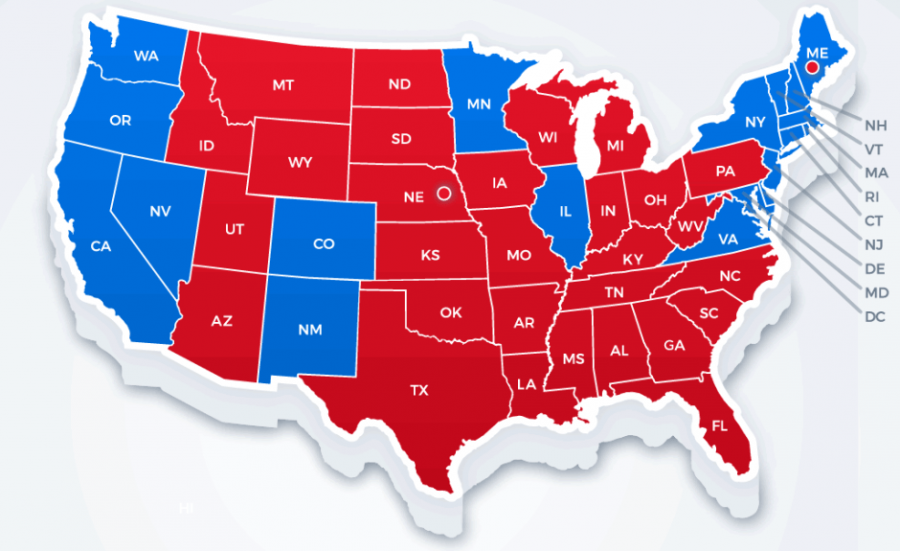Do You Know How The Electoral College Works?
November 4, 2020
Hey! Do you know how the Electoral College works? If not, I’m here to tell you.
If you didn’t already know, the American citizen votes are not the only things that are counted when deciding who the president should be. The votes of the American citizens are what are sometimes referred to as the ‘popular vote’. You may have heard of things like swing states, and if you’re anything like me, you had absolutely no idea what that was. Well if you’re wanting to inform yourself, then we need to start at the beginning.
The United States is the only country that elects the president with something called the electoral college, most other countries (that are democracies) use the popular vote alone. The electoral college is a congregation of delegates from all fifty states, so when the average American citizen votes ‘for the president’ they are just voting for which side their state will take, democratic, or republican. This is the reason that a presidential candidate can sometimes win the presidency without winning the popular vote, which has happened twice in the last 20 years. Most american’s that are aware of how this system is run don’t agree with it, and there’s been unrest about this system for a very long time. Believe it or not, there are a few instances where both political parties have wanted to do away with it, but it was always blocked.
The electoral college works by giving each state a number of representatives based on its population, as well as giving each state two senators. One of the videos I watched to gather this information used Texas and Vermont as examples. Texas has a population of 25,268,000 while Vermont has 630,000. Texas has 36 representatives, and Vermont only has 1. Representatives in both states, when divided up, represent about the same amount of people. In the electoral college the number of delegates for a state mirrors the number of its congressional representatives, plus two for the senators. After factoring this information in, you start to see an issue arise. One representative from Vermont represents 210,000 people, and one representative from Texas represents 664,000 people. This means that A single person’s vote in Vermont has more of an impact on the overall side that the state chooses to represent. Don’t think that a discrepancy like that only exists in this one instance. Issues like this arise all around the country. Take Wyoming and California for example, a single voter in Wyoming matters three times as much as a voter in California.
Now you may be thinking, “Why does all this matter?” Well, It matters because the candidate needs 270 of those electoral college votes to win. Unlike the map of either red or blue states though, no state is made up of all red or all blue states, but almost the electoral votes of each state would beg to differ. The candidate with the majority of the popular vote in a single state gets all of that state’s electoral votes. If they win by 1% then they win the state by 100%. In 2016 4 million people voted for Donald Trump in California, which was the most voters he got from a single state except two, Texas and Florida, but that number doesn’t matter. Hillary Clinton got more votes there, so she got all 55 electoral votes.
Here’s where things begin to get a bit complicated, Hillary never campaigned in California. Why? Because a simple probability equation showed that when would easily win that state. Trump only visited Texas once, because the same equation showed him that he would win their electoral votes easily. So why did they both visit Florida 35+ times? It’s because Florida is what’s classified as a swing state. Being a swing state means that there’s very little that the previously mentioned probability equation can do to help you here. This is because the state doesn’t usually vote one side or the other. In Florida it could go either way, there’s a good mix of both in the state’s history, and Trump only won in florida by 100,000 votes out of over 9 million. “Well you’ve been stalking an awful lot about Florida, has Florida always been a swing state?” No, it hasn’t. Due to the ever changing demographic of this country, swing states have changed over time. For example, In 1996 the swing states were Texas, Tennessee, Arizona, Colorado, Nevada, Montana, South Dakota, Mississippi, Georgia, Kentucky, Virginia, and North Carolina were the swing states. Because these states could go either way, this is where the presidential candidates spend most of their time, also, these states have much more control over the outcome of the election than the others. They could make or break a candidate.
“A study found that voters in Michigan had 51 times the amount of influence on the 2016 election as someone from a state such as Utah, and from the outside looking in, anyone could tell you that that isn’t fair, but it doesn’t stop there. Swing states are where the electing part of the election happens, and that only occurs because of the electoral college.
The electoral college has always been this way, transferring power from one group to another, because that’s how it’s supposed to be. To get more insight on why the electoral college is the way it is, you’d have to look back to when America was first getting colonized. If you want more information on that then I would be happy to write another article, but until then, this is goodbye from your favorite sardonic columnist, Jenna. Have a great day and stay informed.


